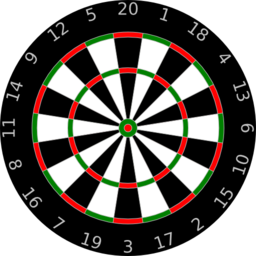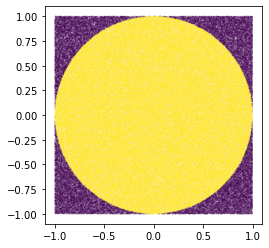Estimating Pi With Py
Using the Monte Carlo method (repeated random sampling to estimate some numerical result) we can estimate the value of \(\pi\). To make it more fun, I wrote the code to match the classic heuristic example: throwing darts at a dart board.
How does one estimate \(\pi\) with darts?
Imagine we have a round dart board hung up on a wall, with a square backdrop no longer than the length of the round dart board. Suppose you were able to throw darts at this board such that the dart always landed within the square, whether or not on the dart board.

Each time you throw a dart, you know whether or not it made it in on to the board. If we throw a lot of darts, then we can estimate the area of the dart board by taking the proportion of darts that landed on the board divided by the total number of darts thrown. This estimate gets better as more darts are thrown. If we can estimate the area of the circular board, and we can measure the radius, then using the formula for the area of a circle, we can estimate \(\pi\).
\[A = \pi r^2 \rightarrow \pi = A/r^2\]Instead of having to throw darts all day, we can have python throw them for us! I wrote a small python script that let’s us play with darts (random points) on a board (the unit circle) with a backdrop (the unit square)
import random
random.seed(42) #set seed to get determined results
We can create a dart, and throw it at the board. It will land in a random spot.
from darts import Dart
my_dart = Dart.throw() # throws the dart, lands in random spot on the unit square
my_dart
Dart(x=0.2788535969157675, y=-0.9499784895546661)
# distance from the origin to where the dart landed
my_dart.distance_from_origin()
0.9900598260354908
We can also make a lot of darts and throw them all at the same time…
from darts import DartSet
radius = 1 # unit circle
n = 250_000 # lots of darts!
%%time
random_points = DartSet.throw_all(n=n) # throw all the darts!
# check if the dart landed in the unit circle
within_circle = [dist < radius for dist in random_points.distance_from_origin()]
# adds up the number of true values, i.e. the ones in the unit circle
darts_in_circle = sum(within_circle)
#total number of darts thrown (in or out of the circle)
total_darts = len(within_circle)
# forms a 2x2 box (from -1 to 1 for x and y)
area_of_unit_square = 4
# this estimates the unit circle area divided by the unit square area
circle_proportion_of_square = darts_in_circle / total_darts
# we know the unit square area, leaving us with the area of the unit circle
area_of_unit_circle_estimate = circle_proportion_of_square * area_of_unit_square
Wall time: 549 ms
Since the area of circle with radius \(r\) is given by \(\pi r^2\), our estimate for \(\pi\) is the just the area of the unit circle, where the radius is \(1\)
pi_estimate = area_of_unit_circle_estimate
print(f'The estimate for pi is {pi_estimate}')
The estimate for pi is 3.140128
Here is a plot of all of our dart throws. The ones that landed on the board are yellow, the others are purple.
import matplotlib.pyplot as plt
plt.gca().set_aspect('equal', adjustable='box')
plt.scatter(random_points.x, random_points.y, c = within_circle, s=.005)
plt.show()

If we really wanted to speed things up, we can use library like numpy.
import numpy as np
%%time
x, y = np.random.uniform(low=0, high=1, size=(2, n))
distance_from_origin = np.sqrt(np.square(x) + np.square(y))
in_unit_circle = distance_from_origin < 1
pi_estimate = in_unit_circle.sum() / len(in_unit_circle) * area_of_unit_square
print(f'The estimate for pi is {pi_estimate}')
The estimate for pi is 3.144608
Wall time: 5.98 ms
Wow! This is around 100x faster than my own vanilla implementation.